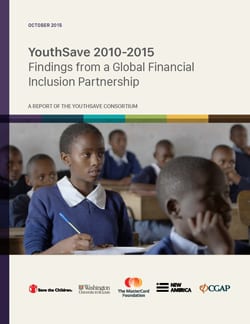In 2010, researchers in the vast YouthSave Initiative started investigating whether low-income youth can build savings in the developing countries of Colombia, Ghana, Kenya and Nepal. Now those researchers’ findings are summarized in the newly released report YouthSave 2010-2015: Findings from a Global Financial Inclusion Partnership. 
The 100-page report offers important insights for the emerging field of youth financial services. It also illustrates how a large-scale research project with an international footprint can execute an ambitious agenda of learning.
Supported by The MasterCard Foundation, YouthSave investigated the potential of savings accounts as a tool for youth development and financial inclusion by co-creating tailored, sustainable savings products with local financial institutions and assessing their performance and outcomes with local researchers. The project is an initiative of the YouthSave Consortium, coordinated by Save the Children in partnership with the Center for Social Development (CSD) at Washington University in St. Louis, New America and the Consultative Group to Assist the Poor.
During the project, youth opened more than 130,000 accounts, with data analyzed on 70,000 accounts. Those account holders, ages 12 to 18, saved more than $1.8 million during the initiative.
CSD designed the research agenda, and its contributions to the final report are extensive. Authors include CSD Director Michael Sherraden, Director of Administration Lissa Johnson, International Director Li Zou, and Faculty Directors Gina Chowa, Margaret S. Sherraden, Fred Ssewamala and David Ansong, who are scholars at other universities. In the report, the researchers emphasize three overarching lessons:
1. Youth saving in developing countries makes a positive difference.
For those who were “unbanked,” saving accounts represent financial inclusion. YouthSave saw 10 to 20 percent of youth in the treatment groups open accounts, compared with less than 1 percent in the control groups, according to the report.
The findings indicate the potential for a large increase in financial inclusion starting early in life if savings accounts were to be offered across a full youth population, the authors say, pointing out that savers’ rates over several years could amount to a significant contribution to expenses for secondary schooling.
In addition, YouthSave participants described social and psychological benefits, such as improved discipline, a sense of pride and excitement, and an orientation toward the future.
“Overall, YouthSave research shows that a meaningful proportion of youth—including low-income youth—in developing countries can save, which has the potential to make a positive difference in their lives,” according to the report. “This finding is YouthSave’s most important contribution.”
2. Savings should engage financial institutions and families—and continue into adulthood.
Policymakers should understand the effects of financial institutions and families on youth saving, the authors say. Strategies should foster saving throughout childhood and youth years. Taking the bank to the youth was the major reason for YouthSave’s success. “Discussion of saving accounts in schools, and especially providing in-school banking (i.e., processing deposits at schools) greatly increased participation,” according to the report.
Researchers also learned that families matter for young savers. Across the four countries, average monthly savings was higher among younger youth. The reason, in part, is that parents are more likely to help younger children save. Also, researchers found higher savings when a parent co-signed the account, suggesting again that parental involvement may contribute to saving success.
The authors also emphasize that starting early matters. The earlier a young person begins saving, the more time savings have to accumulate into a useful lump sum. “Those larger sums in turn translate into greater likelihood for positive outcomes (e.g., to pursue education).” At the community level, the more youth savings becomes a normal practice, the more likely families will be to engage in constructive ways, and the more effective financial institutions will become in reaching out to young savers.
3. Large-scale applied research has continuing payoffs.
Researchers foresee benefits beyond the specific boundaries of the YouthSave project. First, the project created the largest data set on youth savings transactions. Its value is “evident in the very accurate measures of account holding, depositing, and net savings; the ability to assess savings in a robust experimental context; and the ability to identify factors (such as age and gender) associated with savings performance,” they write. “Future researchers will use this data set for additional informative analyses and insights.”
Second, YouthSave’s Ghana Experiment has long-term value. It’s the largest known experimental study of youth saving in a developing country. “Ideally, it would have carried on for a longer period of time, but preliminary results suggest some positive impacts on youth wellbeing. Fortunately, once set up, a good experiment can continue to generate valuable knowledge,” the authors write. In other experiments, CSD has followed participants for as long as 10 years to understand impacts. In Ghana, they expect the partnership with the Institute for Statistical, Social and Economic Research will facilitate follow-ups to see how much YouthSave affects education, employment and earnings.
In addition, the partnerships forged with other researchers have long-term value, according to the report. The YouthSave research agenda relied on local research capacity in each country, and the relationships built over the past five years between CSD and the in-country research partners were essential to the successful execution of YouthSave’s research, the authors write. A foundation also has been built for more collaborations, “which we believe will continue to generate many positive returns in the years ahead.”
Sherraden, principal investigator of the project, said that although CSD led the YouthSave research it would not have succeeded without strong partnerships with these four research institutions: the Universidad de los Andes in Colombia, the Institute for Statistical, Social and Economic Research at the University of Ghana, the Kenya Institute for Public Policy Research and Analysis and New ERA in Nepal.
“CSD is proud of how closely and productively the team has worked during the past five years in implementing this ambitious research agenda,” said CSD’s Zou, YouthSave project director.
Here are more CSD articles about YouthSave: